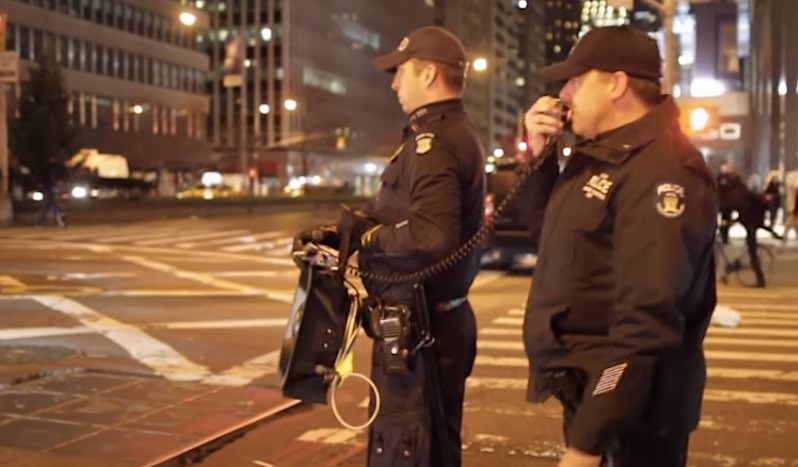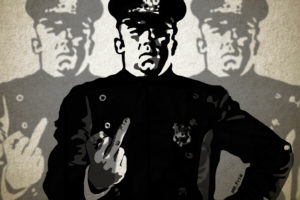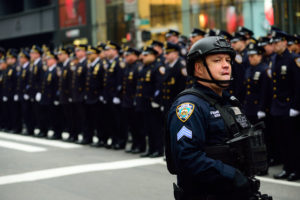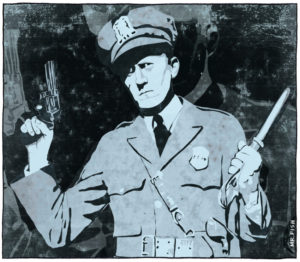The Noise Machine That Quells Dissent
Police in a number of U.S. cities aren't just tasering and tear-gassing protesters, they're attacking their sense of hearing. This screen shot, taken from the video posted below the article, shows NYPD officers using an LRAD in a protest on Dec. 5, 2014. YouTube
This screen shot, taken from the video posted below the article, shows NYPD officers using an LRAD in a protest on Dec. 5, 2014. YouTube
Police in a number of U.S. cities aren’t just tasering and tear-gassing protesters, they’re attacking their sense of hearing. The Long Range Acoustic Device (LRAD), also called a “sound canon,” is a powerful, military-grade electronic megaphone that, in addition to broadcasting police commands, can be used to disperse crowds with a chirping noise reaching 162 decibels, 42 decibels above the level that can cause immediate and permanent hearing damage.
It condenses the noise into an acoustic cone with an angle of 30 to 40 degrees in front of the machine, which can be mounted on a vehicle or held by hand.
The U.S. military has already used the device against enemy combatants whom soldiers wanted to keep at a distance without firing upon them during the Iraq War.
The LRAD’s crowd dispersal function was employed by the New York City Police Department Dec. 4 and 5 at protests over the death of Eric Garner, who died last July in Staten Island after an officer applied a chokehold to him during an arrest. Several protesters are reported to have suffered hearing problems since, including ringing in the ears, but no one has lost their hearing, Elena Cohen, president of the New York City chapter of the National Lawyers Guild, told Truthdig.
The legal advocacy group known as the National Lawyers Guild is worried about the NYPD’s use of the LRAD and has sent a letter to Police Commissioner Bill Bratton expressing concern. The letter also requests information on how much training officers have received in the use of the machine. In the letter the guild argues that, in addition to causing physical harm, the extreme noise from the device might violate First Amendment rights by dispersing legitimate public demonstrations.
“While the modern-day, commercially available LRADs used by the Department can indisputably be used as communication tools – perhaps even safely, under some limited circumstances – they are designed to perform crowd control and other functions – to modify behavior, and force compliance, by hurting people,” the letter reads.
“We know it was used in New York in 2004 in the megaphone, communications mode, and we think it was used once or twice during Occupy Wall Street in the communications mode,” Cohen said. “These past few weeks are the first time we think it’s been used in its deterrent mode—a siren-like sound you hear when you walk through an area.”
A professor who experienced permanent hearing damage from an LRAD the police force aimed at protesters at Pittsburgh’s G-20 Summit in 2012 received a $72,000 settlement from that city.
“If the government wants to prohibit First Amendment-protected speech and conduct, it has to have the means be narrowly tailored,” Cohen said. “A military-grade device that goes up to 160 decibels and makes contact with every single person within hundreds of feet of it does not seem narrowly tailored to us.”
Cohen said there is documentation of the LRAD being used by the U.S. military against Somali pirates. “Now we have the police using it against people protesting,” she said.
Opponents of the domestic use of the LRAD say the setting in which is it employed is significant. Cohen said the only known NYPD testing of the device was in an abandoned parking lot in the Bronx, which has strongly different acoustics than Manhattan. The effect of high-rise buildings on sound is often a seeming amplification from echoes.
The NYPD tested the effect on hearing only at a distance of 300 feet, according to the guild. In the December protests the police were much closer to activists. “When you look at the video—we don’t have an exact distance—but it is very clear people are much, much closer than 300 feet,” Cohen said. “To me, it looks like people are only roughly 15 to 30 feet.”
“There is a giant concern that a bystander, who walked by right in front of this [device] and has no idea what the machine is, could have their hearing seriously or permanently damaged,” Cohen said. “The way it [the projected sound] moves in a cone, you don’t really hear it unless you’re directly in front of it.”
For the National Lawyers Guild and many protesters, the potential for medical and constitutional harm is clear: The sound cannon can be used to quell legal dissent and cause unnecessary injury.
“Do you think your ability to use your First Amendment rights and protest should be based on how long you can withstand a painful sound?” Cohen asked. The silence following that rhetorical question was deafening.
The YouTube video posted below shows NYPD officers using an LRAD on demonstrators in New York City on Dec. 5, 2014:
Your support matters…Independent journalism is under threat and overshadowed by heavily funded mainstream media.
You can help level the playing field. Become a member.
Your tax-deductible contribution keeps us digging beneath the headlines to give you thought-provoking, investigative reporting and analysis that unearths what's really happening- without compromise.
Give today to support our courageous, independent journalists.



You need to be a supporter to comment.
There are currently no responses to this article.
Be the first to respond.